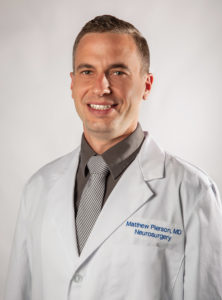Request an Appointment
Please call our office at 816-363-2500 to make an appointment. Don’t forget to bring your imaging studies with you.
What is Arteriovenous Malformation?
Patients suffering from conditions within the skull, like arteriovenous malformation (AVM), may require a craniotomy.
An arteriovenous malformation, or AVM, is a knot of abnormal arteries and veins. They have a high tendency to bleed, most often in young and middle-aged adults. AVMs can form in any part of the body, but they are especially of high concern when they form in the brain because of the risks of bleeding in this area. The size and location of AVMs vary in the brain. AVMs affect less than one percent of the population.
The type of treatment is based upon the size and location of the AVM. Treatment options include embolization, radiation therapy, and surgical removal. The advantage of surgical treatment is that a cure is immediate if all the AVM is removed. Some disadvantages include risk of bleeding, damage to nearby brain tissue, and stroke. Some AVMs in the brain are best treated by a craniotomy.
A craniotomy is a surgical procedure that involves removal of a portion of the skull to access the brain. This surgery is performed by a neurosurgeon while the patient is under anesthesia. A craniotomy can be performed on any part of the skull depending on the location of the brain that needs to be accessed. The portion of the skull that is cut out is called a bone flap.
Causes of Arteriovenous Malformations
Arteries are connected to veins by structures called capillaries. AVMs are formed when arteries connect to veins without the presence of capillaries. AVMs can rupture and this results in blood escaping from the vessels and leaking into the brain and surrounding tissues. The flow of blood to the brain may also be reduced as a result of this bleeding, and the resultant blood clot can damage the surrounding brain.
Symptoms & Diagnosis of Arteriovenous Malformations
The symptoms depend on the size and location of the arteriovenous malformation. An AVM may not exhibit any symptoms in some cases. Possible symptoms include seizures, headaches, and stroke-like symptoms.
The following tests may be used for diagnosis of arteriovenous malformations: cerebral angiography, magnetic resonance imaging, or MRI, magnetic resonance angiography, or MRA, and computerized tomography, or CT, scans.
Cerebral angiography helps to detect the size, location, and configuration of arteriovenous malformations. MRI and MRA help produce detailed images of the blood vessels and brain can highlight AVMs. CT scan can show bleeding into the brain.
Before the Procedure
The patient lies on an operating table and is given general anesthesia. We then place their head in a device to keep their head in a fixed position during the procedure.
Initial Incision
Some hair may be cut to clear the incision area. The surgeon makes an incision in the skin. Next, the skin and surrounding muscles are moved aside.
Exposing the Dura
The bone in the exposed part of the skull is cut and the bone flap is lifted, this exposes the covering, called the dura, that protects the brain tissues.
Locating the AVM
The dura is cut and we locate the AVM and surrounding blood vessels.
Removing the AVM
We separate the brain tissues around the AVM from the AVM, which is then removed.
Ending the Procedure
The surgeon closes the dura and places the bone flap back in its original position. Tiny plates and screws are used to secure the bone flap and keep it in place. Finally, the skin is restored to its original position and secured.
What happens after this treatment for Arteriovenous Malformation?
After surgery, we move the patient to an intensive care unit, or ICU, for close monitoring of their vital signs. They may stay on a ventilation and breathing tube for some time.
After the procedure, the patients may have a headache or feel nauseated. The patient will remain in the hospital for a few days and receive some short-term rehabilitation.
This material is intended to give the patient an overview of surgical procedures and treatments and is not intended to replace the advice and guidance of a physician. Always consult with your doctor about the particular risks and benefits of your treatment.
Request an Appointment
Please call our office at 816-363-2500 to request an appointment.
Be sure to bring all imaging studies with you for your appointment.





 The Highest Quality of Neurosurgical Care
The Highest Quality of Neurosurgical Care